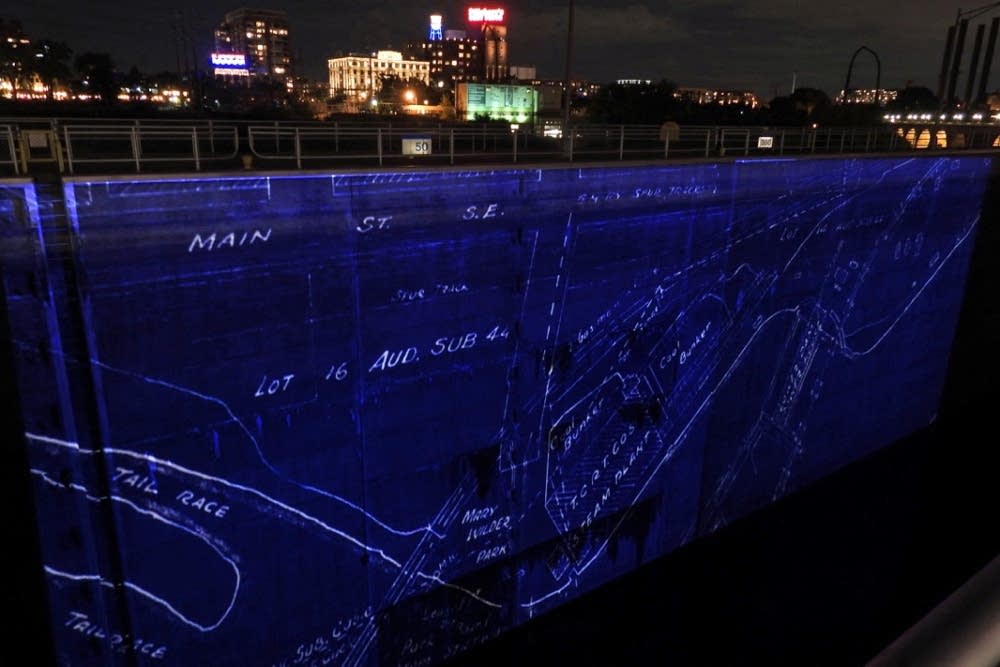By Kirsti Marohn for MPR
A nonprofit group has unveiled early concepts for returning land next to St. Anthony Falls in downtown Minneapolis to Dakota tribes, and creating a place of restoration, healing and connection to the water.
The three acre site west of the Stone Arch Bridge was traditionally a sacred place for the Dakota people, before the river was changed irrevocably by the milling industry and the construction of a lock and dam.
The U.S. Army Corps of Engineers closed the lock in 2015 to prevent the spread of invasive carp. Since then, the agency has been seeking to transfer the lock and adjacent land to local ownership.

Joggers cross the Stone Arch Bridge in Minneapolis on Dec. 20. Image: Ben Hovland, MPR News.
In 2016, Friends of the Falls’ original idea for the site was a visitor’s center focused on the city’s milling industry. But that took a major shift after group leaders engaged with Dakota tribes and learned more about the cultural and historical significance of the place.
Now, the group is discussing with Dakota nations, along with the city of Minneapolis, the possibly of returning the land to tribal ownership.
“What I didn’t know is that indigenous Native populations thrived at the site for thousands of years, hundreds of generations,” said Mark Andrew, retiring president of Friends of the Falls, during a Friday presentation.
“They came, they lived, they celebrated, they mourned, they gave birth. And I only learned in the past three years how profound the presence of Indigenous people is to not only Native American culture, but to the history of our city.”
Design concepts
Friends of the Falls has been working with the Native American Community Development Institute on design ideas for the St. Anthony Falls site. Early conceptual drawings include native landscape, walking paths, places to gather and connect to the river.

Upper St Anthony Falls design concept: An aerial view of a design concept released Friday by the Friends of the Falls non-profit for the redevelopment of the area around the Upper St Anthony Falls. Courtesy photo of Friends of the Falls.
“There’s this idea of making this a place where people can touch the water, again — where the water is allowed, is bringing things to life,” said project director Kjersti Duval, CEO of Duval Companies. “So to transform that kind of industrial landscape into what could be an incredible and accessible restored native landscape, where people can gather, where you can go down to the water.”
New leadership
On Friday, the group announced that Shelley Buck, a former tribal leader of the Prairie Island Indian Community, will replace Andrew as president. The group’s board of directors is now majority Native-led.
Buck said most Minnesotans aren’t taught about the history of the state pre-European contact.
“The fact that Friends of the Falls made that huge change over to wanting to tell that story is just enormous,” Buck said.
Bringing in Native people to facilitate the conversation and take over leadership of the organization is “just unheard of,” she said.
Buck said there needs to be more discussion and gathering input from the Dakota tribes before any decisions are made about ownership of the site.
Spirit Island
As a Dakota woman, Buck said it’s important to her that any plans include an acknowledgment of where Spirit Island once stood. It was known as a place where Dakota people gathered to pray and women gave birth before the island was quarried for limestone to help build Minneapolis.
“It has a spirit of presence about it,” Buck said. “It’s vital for me to make sure that we recognize that being and that spirit that is there, was there and will always be there.”

In 2017 “Illuminate the Lock” projected images of Spirit Island on the huge walls the now closed lock at St Anthony Falls. The limestone island was a Dakota sacred site in the Mississippi which was removed over the years to facilitate navigation. Ojibwe artist Andrea Carlson created hand-drawn images based on photographs from the Minnesota Historical Society’s collection which chronicle the island’s dismantling between the 1890s and the 1960s. Image: Courtesy of Andrea Carlson.
The Army Corps of Engineers is expected to convey ownership of the land to the city of Minneapolis or a designee sometime this year. Duval said the Friends of the Falls and the tribes will need to come together after that to decide the next steps.
“Everyone is committed to that process, to move toward ultimately realizing the vision here,” she said.


